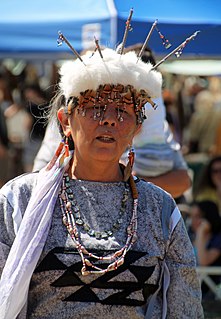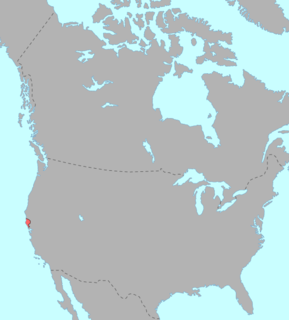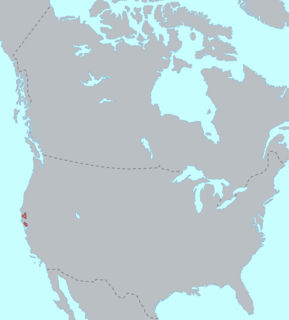
The Pomo are an indigenous people of California. The historical Pomo territory in Northern California was large, bordered by the Pacific Coast to the west, extending inland to Clear Lake, and mainly between Cleone and Duncans Point. One small group, the Northeastern Pomo of the Stonyford vicinity of Colusa County, was separated from the core Pomo area by lands inhabited by Yuki and Wintuan speakers.
The Wintu are Native Americans who live in what is now Northern California. They are part of a loose association of peoples known collectively as the Wintun. Others are the Nomlaki and the Patwin. The Wintu language is part of the Penutian language family.

The Wintun are members of several related Native American peoples of Northern California, including the Wintu (northern), Nomlaki (central), and Patwin (southern). Their range is from approximately present-day Lake Shasta to San Francisco Bay, along the western side of the Sacramento River to the Coast Range. Each of these tribes speak one of the Wintuan languages. Linguistic and archaeological evidence suggests that the Wintun people probably entered the California area around 500 AD from what is now southern Oregon, introducing bow and arrow technology to the region.

The Pomoan, or Pomo, languages are a small family of seven languages indigenous to northern California spoken by the Pomo people, whose ancestors lived in the valley of the Russian River and the Clear Lake basin. Four languages are extinct, and all surviving languages except Kashaya have fewer than ten speakers.

Wintuan is a family of languages spoken in the Sacramento Valley of central Northern California.
The Nomlaki are a Wintun people native to the area of the Sacramento Valley, extending westward to the Coast Range in Northern California. Today some Nomlaki people are enrolled in the federally recognized tribes: Round Valley Indian Tribes, Grindstone Indian Rancheria or the Paskenta Band of Nomlaki Indians. The Nomlaki were bordered by the Wintu (Wintun) in the north, the Yana in the northeast and east, the Konkow (Maiduan) in the east, the Patwin (Wintun) in the south, and the Yuki in the west.One family in the Nomlaki tribe is the Payne family.

The Patwin are a band of Wintun people native to the area of Northern California. The Patwin comprise the southern branch of the Wintun group, native inhabitants of California since approximately 500 AD.

The Miwok or Miwokan languages, also known as Moquelumnan or Miwuk, are a group of endangered languages spoken in central California by the Miwok peoples, ranging from the Bay Area to the Sierra Nevada. There are seven Miwok languages, four of which have distinct regional dialects. There are a few dozen speakers of the three Sierra Miwok languages, and in 1994 there were two speakers of Lake Miwok. The best attested language is Southern Sierra Miwok, from which the name Yosemite originates. The name Miwok comes from the Northern Sierra Miwok word miw·yk meaning 'people' or 'Indians.'
The Lytton Band of Pomo Indians is a federally recognized tribe of Pomo Native Americans. They were recognized in the late 1980s, as lineal descendants of the two families who lived at the Lytton Rancheria in Healdsburg, California from 1937 to about 1960. The tribe now has around 275 enrolled members. It has a casino in San Pablo, California, and has proposed to build housing for tribe members, plus a winery and a hotel, just west of Windsor, California, in Sonoma County.

Eastern Pomo, also known as Clear Lake Pomo, is a nearly extinct Pomoan language spoken around Clear Lake in Lake County, California by one of the Pomo peoples.

Northern Pomo is a critically endangered Pomoan language, spoken by the indigenous Pomo people in what is now called California. The speakers of Northern Pomo were traditionally those who lived in the northern and largest area of the Pomoan territory. Other communities near to the Pomo were the Coast Yuki, the Huchnom, and the Athabascan.

The Yuki–Wappo or Yukian languages are a small language family of western California consisting of two distantly related languages, both now extinct.
Yuki, also known as Ukomno'm, is an extinct language of California, formerly spoken by the Yuki people. The Yuki are the original inhabitants of the Eel River area and the Round Valley Reservation of northern California. Yuki ceased to be used as an everyday language in the early 20th century and its last speaker, Arthur Anderson, died in 1983. Yuki is generally thought to be distantly related to the Wappo language.

Southern Pomo is one of seven mutually unintelligible Pomoan languages which were formerly spoken and is currently spoken by the Pomo people in Northern California along the Russian River and Clear Lake. The Pomo languages have been grouped together with other so-called Hokan languages. Southern Pomo is unique among the Pomo languages in preserving, perhaps, the greatest number of syllables inherited from Proto-Pomo.
Samuel Alfred Barrett was an anthropologist and linguist who studied Native American peoples.

Southeastern Pomo, also known by the dialect names Elem Pomo, Koi Nation Lower Lake Pomo and Sulfur Bank Pomo, is one of seven distinct languages comprising the Pomoan language family of Northern California. In the language's prime, Southeastern Pomo was spoken primarily in an area surrounding East Lake and Lower Lake, in Lake County, along the eastern coast of Clear Lake, in Northern California by the Pomo people. Southeastern Pomos inhabited an area on the northern bank of Cache Creek, and the Sulfur Bank Rancheria. Dialectal differences between the two sites of habitation seem to be minimal, and may be limited to a small number of lexical differences.
The Lake Miwok language is a moribund language of Northern California, traditionally spoken in an area adjacent to the Clear Lake. It is one of the languages of the Clear Lake Linguistic Area, along with Patwin, East and Southeastern Pomo, and Wappo.
Coast Miwok was one of the Miwok languages spoken in California, from San Francisco Bay to Bodega Bay. The Marin and Bodega varieties may have been separate languages. All of the population has shifted to English.

Berryessa Snow Mountain National Monument is a national monument of the United States comprising 330,780 acres (133,860 ha) of the California Coast Ranges in Napa, Yolo, Solano, Lake, Colusa, Glenn and Mendocino counties in northern California. Cache Creek Wilderness is located within the monument.








